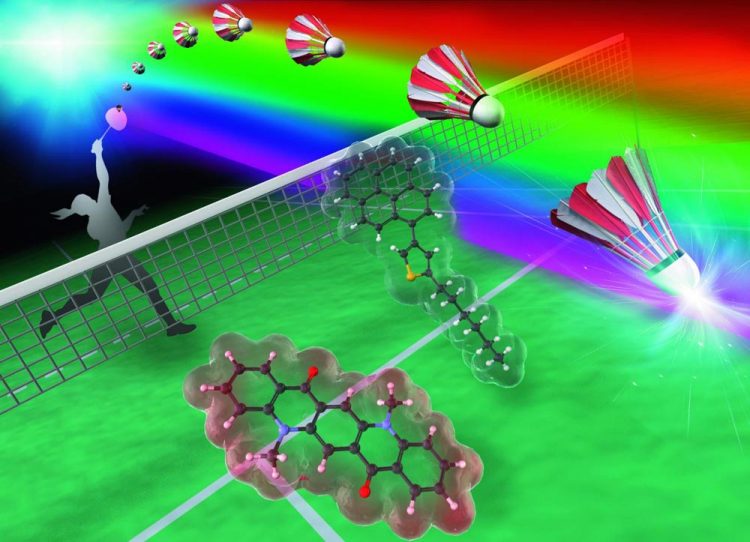Researchers design tunable, self-recovering dyes for use in next-generation smart devices

The two-component dye shows self-recovering mechanochromic luminescence that exhibits a high-contrast emission color change between violet and orange. Credit: Yokohama National University
Now, researchers are working to better control how the chemicals respond to treatment, as well as how to reverse the chemicals back to their original state with little to no interference. Such control would allow scientists to prepare the sensing systems of environmental stimuli, as well as continuously repeat the sensing.
A team of researchers at Yokohama National University has achieved such results with a specific compound that can emit light and has potential applications in the next generation of smart devices such as wearable devices and anti-counterfeiting paintings. They published their results online on September 12, ahead of print in Chemical Communications.
The compound is a derivative of thiophene, which is a dye with mechanochromic luminescence properties — it changes color under physical change. It starts emitting a violet glow under the irradiation of UV light, but as it is exposed to mechanical stimuli, such as grinding, the violet glow shifts slightly to blue. Another external intervention can make the compound heal and become violet again.
“Mechanochromically luminescent (MCL) dyes have recently attracted considerable interest on account of their potential applications,” said Suguru Ito, paper author and associate professor in the Department of Chemistry and Life Science in the Graduate School of Engineering Science at Yokohama National University. “However, it is still very difficult to rationally design MCL dyes with desired characteristics.”
In this study, however, researchers discovered that by adding another chemical called DMQA, the dye changed to orange under mechanical stimuli. The dye did not need more external stimuli to revert back to violet either.
“We combined two kinds of rational design guidelines for tuning the luminescent properties, resulting in the desired — and unprecedented– characteristics of high-contrast, self-recovering dyes,” Ito said.
The first rational design guideline is that the recovery behavior of the dye can be attributed to the length of the alkyl group in the compound — a longer chain of carbon atoms with hydrogens in the dye allows the dye to recrystallize and heal in time. The second is that by mixing with DMQA, the color range between the original state and ground state differ greatly.
“The next step is to establish a rational design guideline to control the dye's responsiveness to mechanical stimuli,” Ito said. “My ultimate goal is to develop an innovative pressure-sensing system by rationally creating a material that can change its emission color in stages in response to mechanical stimuli of different intensity.”
With such control, Ito could use mechanical stimuli to precisely induce a specific and intended response. A little pressure could shift the violet glow to blue, a little more pressure pushes the glow closer to red. A system with such ability would allow for stepwise changes and recoveries by the stimulus, which could be highly beneficial in the next generation of smart materials, according to Ito.
###
Minako Ikeya and Genki Katada, both of the Department of Chemistry and Life Science in the Graduate School of Engineering Science at Yokohama National University, also authored the paper.
This work was supported in part by the Japan Society for the Promotion of Science KAKENHI Grant Number 18H04508 in Grant-in-Aid for Scientific Research on Innovative Areas “Soft Crystals: Area No. 2903”.
Yokohama National University (YNU or Yokokoku) is a Japanese national university founded in 1949. YNU provides students with a practical education utilizing the wide expertise of its faculty and facilitates engagement with the global community. YNU's strength in the academic research of practical application sciences leads to high-impact publications and contributes to international scientific research and the global society.
For more information, please see: https:/
Media Contact
Akiko Tsumura
kenkyu-kikaku@ynu.ac.jp
Media Contact
More Information:
http://dx.doi.org/10.1039/C9CC06406KAll latest news from the category: Materials Sciences
Materials management deals with the research, development, manufacturing and processing of raw and industrial materials. Key aspects here are biological and medical issues, which play an increasingly important role in this field.
innovations-report offers in-depth articles related to the development and application of materials and the structure and properties of new materials.
Newest articles

High-energy-density aqueous battery based on halogen multi-electron transfer
Traditional non-aqueous lithium-ion batteries have a high energy density, but their safety is compromised due to the flammable organic electrolytes they utilize. Aqueous batteries use water as the solvent for…

First-ever combined heart pump and pig kidney transplant
…gives new hope to patient with terminal illness. Surgeons at NYU Langone Health performed the first-ever combined mechanical heart pump and gene-edited pig kidney transplant surgery in a 54-year-old woman…

Biophysics: Testing how well biomarkers work
LMU researchers have developed a method to determine how reliably target proteins can be labeled using super-resolution fluorescence microscopy. Modern microscopy techniques make it possible to examine the inner workings…





















